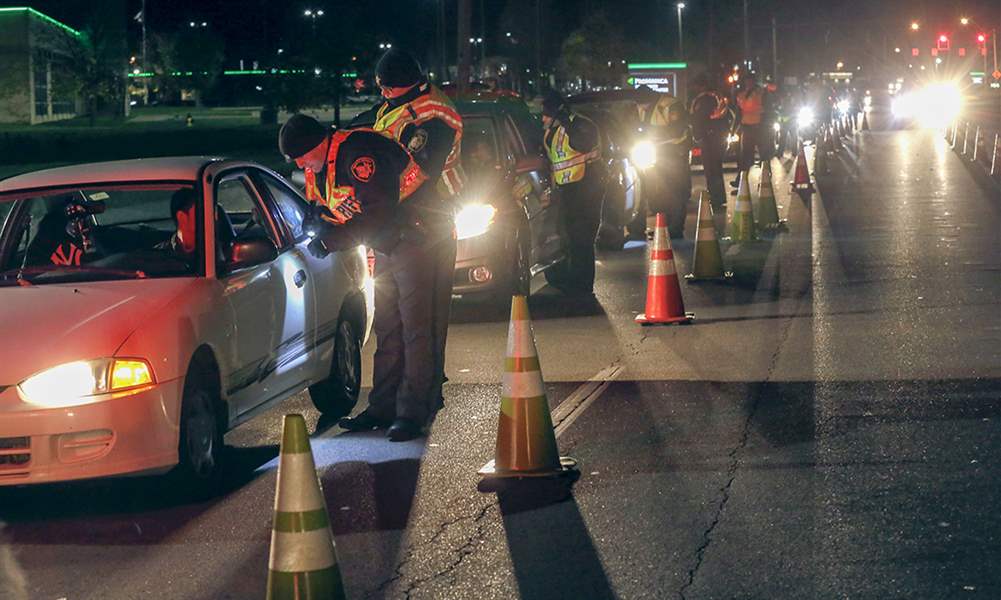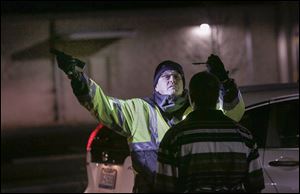
Stop that nabbed OSU quarterback common
But sobriety checkpoints raise legal issues
11/16/2015
Law enforcement officers from more than a dozen agencies conduct a sobriety checkpoint on Reynolds Road. A federal grant paid for the weekend operation.
THE BLADE/LORI KING
Buy This Image

Law enforcement officers from more than a dozen agencies conduct a sobriety checkpoint on Reynolds Road. A federal grant paid for the weekend operation.
Checkpoints for impaired drivers often net few such arrests, but law enforcement officials say the stops send a message beyond citations.
The practice drew widespread attention with the Halloween-weekend arrest of Ohio State quarterback J.T. Barrett. Columbus police stopped 372 vehicles during two nightly checkpoints and arrested four drivers on charges of operating a vehicle while intoxicated.
In Lucas County, an OVI task force conducted 29 checkpoints from October of last year to September. Between one and four drivers are typically arrested for impaired driving at each one, said Robert Sweeney, a Lucas County sheriff’s deputy and task force member.
Judging success on the number of citations misses the point, Deputy Sweeney said. The checkpoints’ most important result is lowering the fatal-crash rate.
These events deter impaired drivers and encourage them to look for an alternative, he said.
The task force on Friday night held sobriety checkpoints in the 6000 block of Dorr Street and 2800 block of Reynolds Road. Of the 570 vehicles through the checkpoints, one motorist was charged with impaired driving. Deputies also cited 12 for driving under suspension and arrested four on warrants. A federal grant paid for the enforcement.
Officials during these stops approach motorists, assess whether they may have consumed drugs or alcohol, and divert potential users for additional tests.
The state mandates a warning to drivers and an option to avoid the checkpoint. Signs indicate the enforcement is upcoming, and motorists can instead turn around.
Patrols monitor that area for traffic violations and stop drivers, Deputy Sweeney said.
“They can drive through, or they can turn off,” he said.
Checkpoints often occur around dates expected to carry heavier drinking, such as celebrations for Thanksgiving, St. Patrick’s Day, and the Super Bowl, he said.
The seemingly counterproductive measure of announcing checkpoints through both media notices and bright signs are in line with federal recommendations.
A 1990 U.S. Supreme Court ruling permitted these stops as a tool for law enforcement to stop drunken driving. The National Highway Traffic Safety Administration followed that year with guidelines to not infringe on drivers’ rights.

Washington Township patrol officer Eric Hart administers the horizontal gaze nystagmus test during a sobriety checkpoint over the weekend along Reynolds Road.
The federal agency said signs are to be posted in advance of the stop, officers must remain on scene, and the location cannot create a traffic hazard. Checkpoints must be “publicized aggressively.”
Twelve states, including Michigan, do not conduct sobriety checkpoints. Michigan determined they are illegal under its state constitution, according to the Governors Highway Safety Association, a Washington-based nonprofit group.
On average, nearly 30 people across the United States die daily in car crashes involving alcohol-impaired drivers, according to the Centers for Disease Control and Prevention. The nationwide annual cost of alcohol-related crashes exceeds $59 billion, the agency said.
The Ohio Highway Patrol determines where its troopers conduct such stops largely by analyzing impaired-driving crash history. Troopers provide general information regarding the stop about a week in advance.
Patrol guidelines allow for troopers to stop every vehicle or a certain number intermittently, as it then remains a random search.
Suspected drivers can undergo tests of their balance, agility, and pupils.
Checkpoints are a good public service to urge the public against drunken driving, said Sgt. Josh Bolduan of the patrol’s Toledo post.
“Some people think of it as a hassle, but you have nothing to hide if you’re not drinking and driving,” he said.
The post conducts about four checkpoints each year and assists other agencies’ scheduled stops. He said troopers record similar arrest numbers as the county task force.
Warning signs are posted about 750 feet in advance of the stop, he said.
In one recent checkpoint along the Anthony Wayne Trail, troopers arrested five people for driving while intoxicated among the several hundred who entered the checkpoint.
“Think about it — that’s at least five lives that are saved,” he said.
Troopers make conversation with the drivers and sometimes ask where they are going. If the motorists are traveling to a bar, the troopers act as a reminder to travel safely, the sergeant said.
“If we don’t arrest any OVI drivers out of it, we’re still educating the public,” the sergeant said.
Mark Davis, a Toledo defense attorney who handles impaired-driving cases, said he does not believe checkpoints are efficient.
The stops delay many drivers who have not consumed any alcohol, Mr. Davis said.
“They might check 500 cars and only have two people with a DUI,” he said.
Advertising campaigns and targeted enforcement of areas where people may drink and drive, such as outside bars as they close, are likely more effective, he said.
“That seems to make more sense than stopping every car at Alexis and Jackman [roads] for two hours,” Mr. Davis said.
Contact Ryan Dunn at: rdunn@theblade.com, 419-724-6095, or on Twitter @rdunnblade.